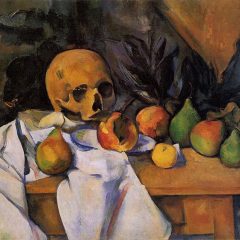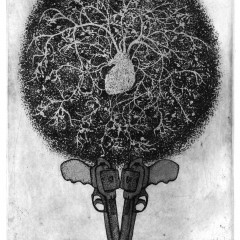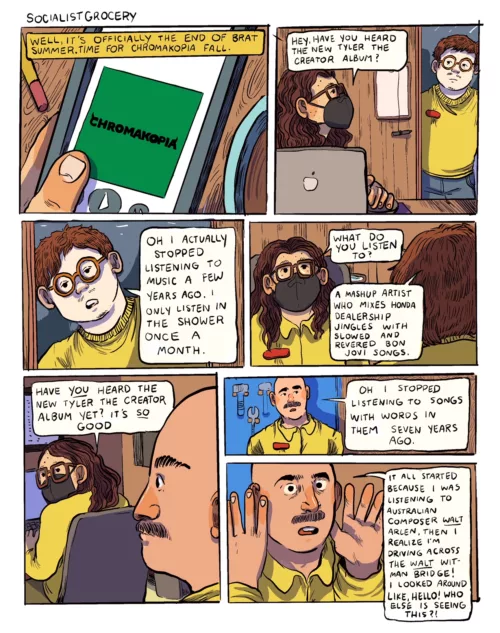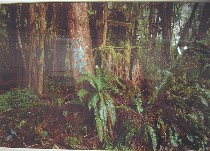 Well, I’m still here while Roberta’s off at Max’s graduation, and I’m thinking about a swell five-photographer show that I saw at the Painted Bride about our planet and the interaction between it and us.
Well, I’m still here while Roberta’s off at Max’s graduation, and I’m thinking about a swell five-photographer show that I saw at the Painted Bride about our planet and the interaction between it and us.Before I write another word, I have to apologize for the quality of the photos I took. They practically destroy what are fabulous photos.
I hate to label “Paradise Paved” at the Painted Bride an eco show, although that is indeed what it is. But the quality of the images–their honesty and beauty–make it also a show on photography, seeing and thinking. Curated by Stephen Perloff, founder and editor of The Photo Review, the show is a reminder of what makes landscapes worth looking at in 2005.
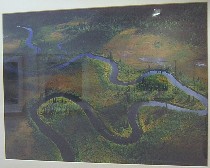 These are not the romanticized, majestic landscapes of Ansel Adams, although Robert Glenn Ketchum’s views of untouched Alaska also reveal a breathtaking beauty along with the similar subtext of “how can you even think of destroying this?” Ketchum’s chromogenic prints are a bit shameless in their va-va-va-voom color and their storybook/fantasy-map compositions, but the result is not so much transcendent, as in Adams, but amazing and lovable. I look at them thinking not God thoughts but Nature thoughts (left, “Rat Creek, Wood-Tichik State Park”).
These are not the romanticized, majestic landscapes of Ansel Adams, although Robert Glenn Ketchum’s views of untouched Alaska also reveal a breathtaking beauty along with the similar subtext of “how can you even think of destroying this?” Ketchum’s chromogenic prints are a bit shameless in their va-va-va-voom color and their storybook/fantasy-map compositions, but the result is not so much transcendent, as in Adams, but amazing and lovable. I look at them thinking not God thoughts but Nature thoughts (left, “Rat Creek, Wood-Tichik State Park”).
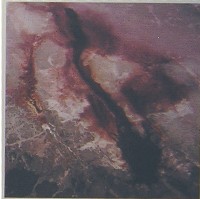 Nor are the photos in this show exactly despairing even when they show destruction at its worst, as in David Maisel’s Lake Project series, taken in California. Rivers running red are a cliche of eco toxicity, but Maisel’s photos have a bizarre, silent beauty–a sort of planet evolution gone mad in the hands of thoughtless man. Here the last laugh is loud and clear, with the carcinogenic environment destroying people as ruthlessly as people have destroyed the environment. It’s not an Alexis Rockman post-apocalypse but rather a view of the natural response of the earth to human error–not pretty but still marvelous.
Nor are the photos in this show exactly despairing even when they show destruction at its worst, as in David Maisel’s Lake Project series, taken in California. Rivers running red are a cliche of eco toxicity, but Maisel’s photos have a bizarre, silent beauty–a sort of planet evolution gone mad in the hands of thoughtless man. Here the last laugh is loud and clear, with the carcinogenic environment destroying people as ruthlessly as people have destroyed the environment. It’s not an Alexis Rockman post-apocalypse but rather a view of the natural response of the earth to human error–not pretty but still marvelous.
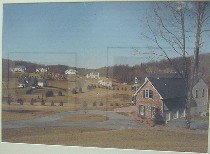 Whether the images are Christine Welch’s views of landscapes subdued by suburban manicure and development or scarred by farming (yes, the noble farmer does his damage, too), or John Ganis’ nearly pristine locales undergoing change thanks to dirt bikers or lumbering, the message is always how amazing the landscape is, both before and after. The regret is there, but again beauty and nature’s substructures remain–so far–but watch out, because soon they will be unrecognizable (left, Welch’s “Rte 113 near Phoenixville, PA,” and at the top of the post, Ganis’ “Hoh Valley Rain Forest,” with trees marked for cutting).
Whether the images are Christine Welch’s views of landscapes subdued by suburban manicure and development or scarred by farming (yes, the noble farmer does his damage, too), or John Ganis’ nearly pristine locales undergoing change thanks to dirt bikers or lumbering, the message is always how amazing the landscape is, both before and after. The regret is there, but again beauty and nature’s substructures remain–so far–but watch out, because soon they will be unrecognizable (left, Welch’s “Rte 113 near Phoenixville, PA,” and at the top of the post, Ganis’ “Hoh Valley Rain Forest,” with trees marked for cutting).
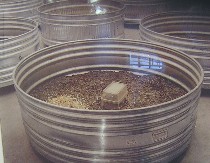 The quirkiest of the photographs in this show came from Joann Brennan, who shows people intervening to save nature. But their methods are so far from romantic, more like garage science, that they are sometimes laughable, sometimes creepy, and always questionable and quixotic (right, a detail of “Voles’ Housing”).
The quirkiest of the photographs in this show came from Joann Brennan, who shows people intervening to save nature. But their methods are so far from romantic, more like garage science, that they are sometimes laughable, sometimes creepy, and always questionable and quixotic (right, a detail of “Voles’ Housing”).While the theme is a perennial at this moment in time–I’m thinking here of my post on Kathryn Frund and Roberta’s post on “Trouble in Paradise” (there’s a red-river Rockman pictured there)–the show is still great for non-knee-jerk content and beauty with analog technology, which still looks great.




